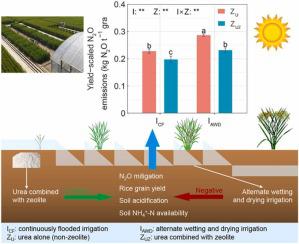Agriculture, Ecosystems & Environment ( IF 6.6 ) Pub Date : 2022-08-30 , DOI: 10.1016/j.agee.2022.108145 Guangyan Liu , Junlin Zheng , Taotao Chen , Xuda Chen , Wei Chen , Yidi Sun , Poul Erik Lærke , Yinglong Chen , Kadambot H.M. Siddique , Daocai Chi , Ji Chen

|
Increasing studies indicate that alternate wetting and drying irrigation (IAWD) can significantly increase water use efficiency in paddy fields, whereas this method may also cause high nitrous oxide (N2O) emissions. Therefore, effective management strategies are urgently required for ameliorating the adverse effect of IAWD on N2O emissions. Zeolite is increasingly used as a potential effective soil conditioner to reduce N2O emissions. However, few studies have been conducted to explore the effect of zeolite on N2O emissions and rice grain yield as well as the associated soil physicochemical properties in paddy fields under IAWD. Here, a two-year field experiment was conducted using lysimeters to assess the effect of two irrigation regimes (ICF: continuously flooded irrigation; IAWD: alternate wetting and drying irrigation) and two zeolite management regimes (ZU: urea alone (non-zeolite control); ZUZ: urea combined with zeolite (15 t ha−1)) on N2O emissions, rice grain yield, and soil physicochemical properties. The results showed that IAWD significantly increased N2O emissions by 18% relative to ICF, and ZUZ significantly reduced N2O emissions under IAWD by 9% compared to ZU. IAWD had no significant effect on rice grain yield compared to ICF. However, ZUZ significantly enhanced rice grain yield under ICF and IAWD by 11% and 14%, respectively, compared to ZU. Accordingly, ZUZ significantly decreased yield-scaled N2O emissions under ICF and IAWD by 13% and 19%, respectively, compared to ZU. Increases in soil NH4+-N concentrations and soil pH contribute to the N2O mitigation in ZUZ under IAWD. Altogether, our results highlight that zeolite combined with urea is likely a sustainable resource-efficient approach for mitigating N2O emissions while increasing rice grain yield in paddy fields under IAWD.
中文翻译:

沸石在干湿交替灌溉条件下减轻稻田的 N2O 排放
越来越多的研究表明,干湿交替灌溉 (I AWD ) 可以显着提高稻田的用水效率,而这种方法也可能导致高浓度的一氧化二氮 (N 2 O) 排放。因此,迫切需要有效的管理策略来改善 I AWD对 N 2 O 排放的不利影响。沸石越来越多地用作减少 N 2 O 排放的潜在有效土壤调节剂。然而,很少有研究探讨沸石对I AWD条件下稻田 N 2 O 排放和水稻产量以及相关土壤理化性质的影响。. 在这里,使用蒸渗仪进行了为期两年的田间试验,以评估两种灌溉方式(I CF:连续漫灌;I AWD:干湿交替灌溉)和两种沸石管理方式(Z U:单独使用尿素(非-沸石控制);Z UZ:尿素与沸石结合(15 t ha -1))对 N 2 O 排放、稻谷产量和土壤理化性质的影响。结果表明,I AWD相对于 I CF显着增加了 18% 的N 2 O 排放,而 Z UZ在 I AWD下显着降低了 N 2 O 排放与 Z U相比减少 9% 。与 I CF相比, I AWD对水稻产量没有显着影响。然而,与 Z U相比,Z UZ在 I CF和 I AWD下显着提高水稻产量分别为 11% 和 14% 。因此,与 Z U相比,Z UZ在 I CF和 I AWD下显着降低了产量规模的 N 2 O 排放量,分别为 13% 和 19% 。土壤 NH 4 + -N 浓度和土壤 pH 值的增加有助于在 I 下Z UZ的 N 2 O 缓解四驱。总之,我们的研究结果强调,沸石与尿素结合可能是一种可持续的资源节约型方法,可在 I AWD条件下减少 N 2 O 排放,同时增加稻田的稻谷产量。


























 京公网安备 11010802027423号
京公网安备 11010802027423号